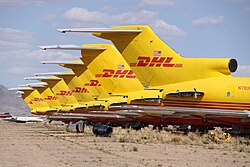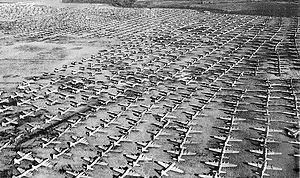Kingman Airport (Arizona)
| Kingman Airport | |
|---|---|

|
|
| Characteristics | |
| ICAO code | KIGM |
| IATA code | IGM |
| Coordinates | |
| Height above MSL | 1051 m (3448 ft ) |
| Transport links | |
| Distance from the city center | 15 km northeast of Kingman |
| Basic data | |
| opening | 1940s |
| operator | City of Kingman |
| surface | 1700 ha |
| Runways | |
| 03/21 | 2081 m × 46 m asphalt |
| 17/35 | 2050 m × 23 m asphalt |
The Kingman Airport (also Mohave County Airport ) ( ICAO code : KIGM , IATA code : IGM , FAA code: IGM ) is an airfield 15 km northeast of the city center of the resort Kingman located in Mohave County in the US state of Arizona . It is currently not served by scheduled air traffic , but is one of the largest aircraft graveyards in the United States. As it is used by fewer than 2500 passengers per year, it is classified as a general aviation aerodrome .
history
1942–1945: USAAF training airfield
The airfield was built during the Second World War from 1942 as a training airfield for the United States Army Air Forces (USAAF) and was primarily used for training gunmen . The fighter types Bell P-39 Airacobra and Bell P-63 Kingcobra , which the Western Allies had classified as not suitable for the front, were available as target aircraft . As of May 1943, the facility was officially called Kingman Army Air Field .
1945–1948: Disposal of surplus war aircraft
After the end of the war, the Reconstruction Finance Corporation organized five large centers for the storage, sale and scrapping of the approximately 117,000 surplus USAAF aircraft as the recovery authority for war material. In addition to Kingman, these were located in Albuquerque (NM), Altus (OK), Ontario (CA) and Walnut Ridge (AR). In addition, 30 smaller intermediate storage locations and 23 sales centers were set up. The task was taken over from March 1946 by the War Assets Administration .
From autumn 1945 up to 150 aircraft per day were flown to Kingman ( "Storage Depot 41" ). At the end of 1945 4,700 redundant or obsolete machines had arrived there, and in 1946 there were 5500.
In addition to countless B-17 bombers, 38 Consolidated B-32 Dominator heavy bombers were also scrapped there - almost all of them brand new, after just one flight straight from the manufacturer's plant.


Up to 35 aircraft per day could be melted down in three blast furnaces operating around the clock for aluminum production. In July 1948 the action was completed. The result of recycling:
- 85 reconnaissance and training aircraft
- 615 fighters
- 54 light bombers
- 266 medium bombers
- 4463 heavy bombers
a total of 5483 machines were scrapped.
Average prices achieved for surplus aircraft (for scrapping or for further use):
Training aircraft
Fighter planes
bomber
- A-26 $ 2,000
- B-17 $ 13,750
- B-24 $ 13,750
- B-25 $ 8,250
- B-26 unknown
- B-32 unknown, only given for scrapping
post war period
Again since the 1960s, Kingman has been increasingly used as an aircraft graveyard for scrapping, now also as a parking space for commercial aircraft that have been parked for a long time . In 2014, more than 70 companies had settled on the industrial park at the airport.
Airlines and Destinations
The airport is currently not served by airlines in regular service . Until a few years ago there was a connection from Great Lakes Airlines to Los Angeles , which was served by turboprop feeder aircraft of the type Beechcraft 1900 .
Web links
- Kingman Airport & Industrial Park
- Data from the American Air Traffic Control Authority (FAA) on the airfield
- Airplane boneyards
- Aeronautical chart for Kingman Airfield on SkyVector.com
Individual evidence
- ↑ Kingman Airport ( English ) In: Geographic Names Information System . United States Geological Survey . Retrieved August 22, 2016.
- ↑ Website of the airfield ( Memento of the original from February 21, 2015 in the Internet Archive ) Info: The archive link was inserted automatically and has not yet been checked. Please check the original and archive link according to the instructions and then remove this notice. , Air Service
- ↑ FAA, Airport Listings of General Aviation Airports Appendix B-1: Summary by State (English) , accessed on June 3, 2015
- ↑ a b Airplane Boneyards
- ↑ Joseph F. Baugher: USAAF-USAF Military Aircraft Serial Numbers (English) , accessed on June 3rd, 2015


